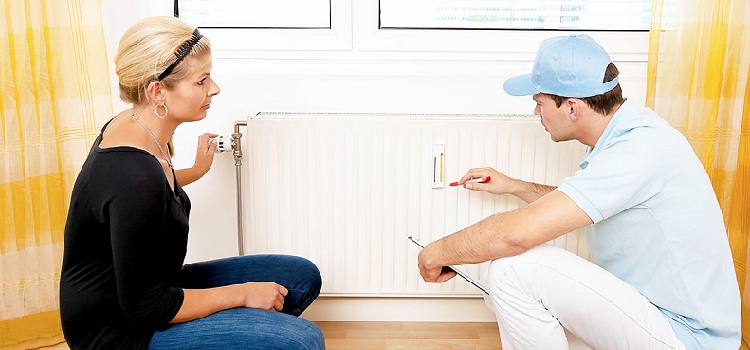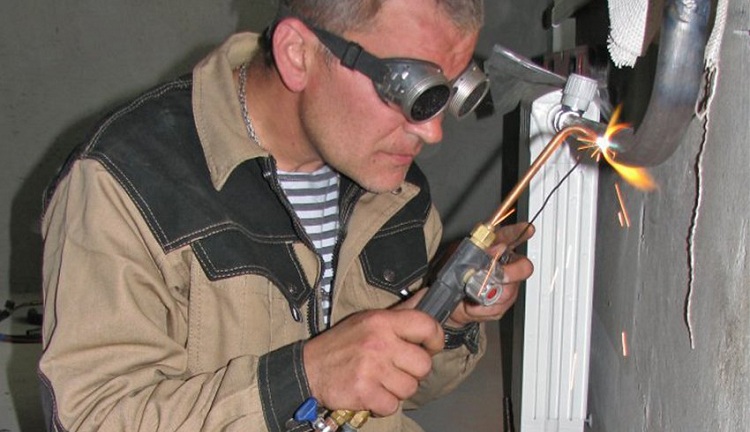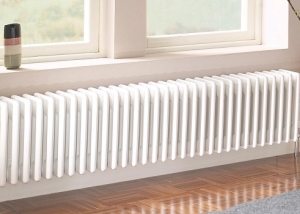Starting a major overhaul in a city apartment, one cannot ignore the side of communication. An extraordinary replacement of heating pipes in an apartment is much better than an emergency when the system becomes unusable after finishing work. Significant wear of pipes and clogging of radiators are the reasons for their replacement with a new heating system. This is a time-consuming and costly process, but if you choose the materials carefully and make the replacement of your own heating at least partially, the costs will be negligible.

The installation of a new heating system is associated with a number of tasks, for the solution of which specialist assistance may be required
Content
Dismantling the risers
Replacing a heating system increases its efficiency. To increase the efficiency, it is important to completely dismantle the old supply lines and radiators within the apartment, and best of all, the riser. If possible, it is better to negotiate with the neighbors above and below so that new pipes pass along the entire vertical of the entrance. With neighbors, it is also worth deciding which type of pipe is a priority. The volume of work, costs and installation technology depend on this. If consensus cannot be found, the old communications will have to be cut within their living space and universal couplings should be installed to connect to minimize leakage.
In any case, it is better to inform the housing office workers about the replacement of the heating system wiring within the same apartment. This is inevitable if it is necessary to block the riser during repair during the heating season. It is better to replace pipes or a single fragment in the warm season, but it will be possible to check the tightness only with the beginning of the heating season. The worst thing that can happen is a leak during system startup from a water hammer. This can be counteracted by installing additional clamps at the joints of the elements of the system.
What is important to know about replacing pipes in a heating system?
Before the final choice of material for replacing heating pipes and budgeting, it is important to understand the main indicators:
- Workload and system pressure.
- The average temperature of the coolant.
- Estimated Life
- The most permissible load.
For example, if an apartment building is being prepared for demolition, then it makes no sense to put expensive products with a maximum service life. Heating is replaced in a residential building only after the system is shut off and water is drained from it.
Advice! It is worth taking care of energy-saving technologies. After the old cast-iron batteries have been removed, it is better to shield their niches with foil materials so as not to unnecessarily heat the walls of the house. If at the same time as replacing heating radiators old windows are changed and external wall insulation is done, this will save heat as much as possible during the heating season.
Cutting old pipes is easiest with a grinder. In order not to damage the finish, it is recommended to install a metal shield behind the pipes near the wall. When removing, it is important to make an even perpendicular cut so that it is easier to place articulation elements between old and new parts, for example, from metal plastic.After shielding the niche for the batteries, I make a marking to drill holes for installing holders with a puncher that will securely fix new radiators. By this time they should be acquired, design, material and color are selected for the general decor of the interior. Checking the horizontal of radiators is important to prevent accumulation inside them, so that it does not interfere with the full circulation of the coolant.
After installing heating radiators, they begin to purchase and replace heating pipes in the apartment. The diameters of the radiator pipe and old pipes must match. If there is a slight difference, then use adapters and connectors with different cross-sections. A single diameter is important for the smooth circulation of warm water in the system and to reduce sludge.
In order to make a competent calculation of the number of elements for a house wiring of the heating system, it is important to draw up the correct drawing, taking into account the double-circuit or single-circuit type.
In some cases, it is necessary to replace the heating pipes of an apartment building or a private house before they become unusable:
- Low efficiency of the heating system with clogging of radiants (the riser has hot water and the batteries are cold);
- The wiring diagram is ineffective or weak (a one-room apartment is tied to a "return", and the room is always cold);
- Existence of excess air in the system, noisy water supply.
Heating system diagram
Before starting the replacement of heating pipes, you will have to deal with a variety of systems:
- A single pipe system with hot water, where products with a diameter of 25-32 mm are used, the connection to the radiator may be a bit narrower.
- In a two-pipe system, the hot coolant flows along a straight section of the system and is discharged in a different way - the "return". If the apartment has many windows, respectively, and radiators, then they select wider pipes.
With any method of supplying and discharging hot water to the apartment, do not forget to weld 2 shut-off ball valves into the system, which, if necessary, will block the supply of hot water and the "return". It is even better when it is possible to shut off water in the event of a leak in each room.
Advice! If a private house is under construction, it is better to order drawings of the wiring of the heating system from a specialist who will make all the calculations for the load and power.
The choice of material of heating pipes
The following types of products are used for the heating system:
- metal (steel, stainless steel, galvanization, ferrous metal, copper);
- polypropylene (with fiberglass or aluminum reinforcement);
- metal-plastic;
- polypropylene.
Each material has its advantages and disadvantages, especially the installation and connection with other materials:
1. Copper products are the most expensive and durable. It makes sense to install during the overhaul, when there is a radical arrangement of the apartment and it is not planned to replace the communications in the coming years.
The main disadvantage is the difficulty of tin soldering, which only specialists can do. If the repairs are done mainly with their own hands, then the dismantling of the old wiring and radiators is easiest to do on their own, and let the pros install the pipes from copper. The advantage is stylish copper heating radiators.
2. Steel products - the usual material, the connection can be entrusted to anyone who has the skills to work with the welding machine. These pipes are durable, affordable and reliable.

Metal pipes are a common material for heating installation, but a welder is required to assemble them
The main disadvantages - rust inside the coolant gradually clogs the system. During welding, be sure to close the floor and walls with shields so as not to damage the spark and molten metal. It is better to make welding before the floor is updated in the apartment.Scraps of old metal pipes with metal-plastic and polymers are connected through threaded adapters and couplings. To protect against external corrosion and improve the appearance of steel products, it is customary to paint them. Suitable for any metal heating radiators, since the linear expansion of metals during heating is approximately the same.
3. Polypropylene products (PPR) have an aesthetic appearance, they do not have to be painted. The products are flexible but very durable, a great alternative to metal pipes. Do-it-yourself installation is available, so the cost of the material can easily be compensated for by saving on self-replacing pipes. The installation of expansion joints on polymer pipes minimizes water hammer by reducing linear expansion. It will not be felt on neighboring floors. Pipes perfectly retain the temperature of the coolant, so radiators are an order of magnitude warmer than in similar systems.
The cost-effectiveness of a heating system with PPR pipes will be most obvious if the entire staircase using a collective heat meter is switched to them. These products tolerate high temperature inside, without deformation and softening - they are reinforced with fiberglass. Replacement of such products will not be required soon. When installing a new heating system, the soldering method is used, and joining with products from other materials is quite simple - adapters, couplings and fittings.
4. Another modified polymer is polyvinyl chloride or PVC. Pipes from this material are also becoming increasingly popular in the repair of heating systems. A polymer with minimal linear expansion, the pipes are practical, but not for critically high temperatures. Like similar materials, it involves soldering and mounting on fittings.
Competent pipe welding eliminates narrowing of the lumen, so it is important to adhere to the technology and be extremely accurate. Such parts do not have to be painted, but this is an additional savings. If there is no hot water in the riser, these pipes do an excellent job of their function in the heating system.
5. Pipes made of metal-plastic for heating are becoming more and more popular, replacing metal analogues. They are cheaper than other synthetic materials, but are quite reliable and durable. They have a completely aesthetic appearance, so they do not have to be painted or hidden somehow. Sufficient product flexibility reduces bends and pipe lengths along the way to the radiators. They withstand temperatures up to 95 ° C.
Installation of these products involves special equipment and fittings. The small thickness of these pipes is an additional risk in case of a possible sharp impact with a sharp metal object and other mechanical damage. Metal-plastic easily gives off heat; therefore, such pipes partially cool the coolant during supply to the radiators. Once having mastered the installation of metal-plastic heating pipes, such work will easily be done independently - as needed.

When installing metal-plastic pipes, special fittings and crimping pliers are used, this method gives a reliable connection
Connection of heating radiators when replacing pipes
Modern heating radiators are available in various materials, including bimetallic and traditional cast iron. Different color and design - the ability to select batteries for living rooms of any design, so that you do not need to hide them behind shields.
It is interesting! A large radiator volume is an advantage, such products do not clog, and their surface area gives off maximum heat. The main place where rust and calcium deposits are most often deposited is the narrowing of the lumen at the joints with the pipes. Therefore, proper installation should pay more attention when replacing heating, so that you do not have to clean the system soon.
Radiators are mounted on the brackets installed in the niche; pipes from the material to which preference was given are brought to them.Be sure to check the horizontal again so that they do not tilt. The flow rate of radiators and the likelihood of air accumulation depend on the level. It is recommended that the wall be pre-shielded so that it does not absorb some of the heat from the battery. It is important to maintain a gap between radiators and adjacent planes - at least 5-10 cm.
In a one-pipe scheme, a “Majewski tap” is installed on the upper block of the radiator to let out air, and the lower hole must be welded or tightly closed with a cork. It is important to decide in advance where the taps will be in order to shut off the water in the event of an emergency break. The pipe going to the neighboring floors through the gates in the ceilings and floors must be provided with thermal insulation. It is advisable to provide waterproofing in the niches under the batteries. During the replacement of the entire riser of the heating system, a jumper is installed so that with closed taps on individual radiators, other users have access to heat.
With proper articulation of any type of pipe in a city apartment, depressurization of the heating system is excluded. If in doubt, it is better to make an additional seal with silicone or tow with grease under the clamps. When replacing pipes, joining is carried out strictly according to the technology of each material, observing the correspondence of the diameters of the pipes and all connecting elements.







